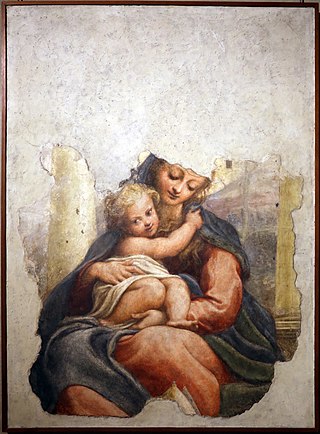
Villa del Poggio Imperiale is a predominantly neoclassical former grand ducal villa in Arcetri, just to the south of Florence in Tuscany, Central Italy. Beginning as a villa of the Baroncelli of Florence, it was seized by the Medici, became the home of a homicidal and unfaithful husband, and a lavish retreat for a Grand Duchess with imperial pretensions. Later given to Napoleon's sister, it was reclaimed by the hereditary rulers of Tuscany before being finally converted to a prestigious girls' school. During its long history, it has often been at the centre of Italy's turbulent history, and has been rebuilt and redesigned many times.

The Orto Botanico di Firenze, also known as the Giardino dei Semplici, the "Garden of simples", is a botanical garden maintained by the University of Florence. It is located at Via Micheli, 3, Florence, Italy, and open weekday mornings.

The Viali di Circonvallazione are a series of 6-lane boulevards surrounding the north part of the historic centre of Florence.

Piazza Cesare Beccaria is a square of Florence located on the viali di Circonvallazione, the boulevard along the route of the former walls of Florence.

Batignano is a small town in southern Tuscany, a frazione of the comune of Grosseto, positioned at about 10 km north-east of the capital on one of the last foot-hills of the valley of Ombrone which dominated the ancient city of Roselle.

The Teatro Alfieri was a major theatre and opera house in 18th and 19th century Florence, located at Via dell'Ulivo #6 corner Via Pietrapiana in the Florence, region of Tuscany, Italy.
The following is a timeline of the history of the city of Florence, Tuscany, Italy.

The Casino Mediceo di San Marco is a late-Renaissance or Mannerist style palace located on Via Cavour number 57 and via San Gallo in Florence, region of Tuscany, Italy.

The Palazzo Giugni, also called the Palazzo Firenzuola, is a late-Renaissance or Mannerist architecture palace designed by Bartolomeo Ammanati, and located on Via degli Alfani #48 in the quartiere San Giovanni of Florence, region of Tuscany, Italy. It is located down the street from the Brunelleschi's church of Santa Maria degli Angeli.

The Triumphal Arch of the Lorraine located in Piazza della Libertà in Florence, Italy, is an 18th-century, monumental triumphal arch, bypassed by the viali di Circonvallazione that skirt Florence through the space once girded by its 16th-century walls. The piazza stands at the northernmost end of Via Cavour, Florence, region of Tuscany, Italy.

Porta a Pinti was a former gate in the walls of Florence, region of Tuscany, Italy. The gate was also called Porta Fiesolana because the road led out to Fiesole, and of di Penitenti, which was shortened and corrupted to give name to the gate and the neighborhood, Borgo Pinti. Individuals returning to church, called convertiti or penitenti, lived in this neighborhood. It was destroyed in 1865 during the creation of the Viale di Circonvallazione, which removed most of the walls of Florence.
The Pia Casa di Lavoro di Montedomini is a large complex of buildings in Florence, Italy; the complex took shape in 1812, on the site of two expropriated former monasteries, where the Napoleonic government built a poor-house. The complex is bound by Via dei Malcontenti, Via delle Casine, Via Pietro Thouar and the Viale della Giovine Italia. The complex is located in the quartiere of Santa Croce, east of the city, north of the Arno river, and just within the 16th-century city walls.

The Porta Romana, once known as the Porta San Pier Gattolino was the southernmost gate in the 13th-century walls of the Oltrarno section of Florence, region of Tuscany, Italy. It stands at the confluence of a number of roads: accessed from north by Via Romana, Via de' Serragli, and Viale Francesco Petrarca. In addition, a central road along the Boboli Gardens begins near the gate, and allowed the inhabitants of the Pitti Palace to exit and enter Florence with minimal travel on city streets. Beyond the gates are the Via del Poggio Imperiale and Via Senese. The latter led to Siena and points south such as Rome, hence the name. When the majority of the defensive walls of Florence were razed in the 19th century, only a few, and sometimes partial gate structures were left standing including San Gallo Gate, Tower of San Niccolò, and this gate with a snippet of merlonated wall.

43°45′46.95″N11°15′23.48″E

The Reale Museo di Fisica e Storia Naturale was an Italian museum founded on 22 February 1775 in Florence that survived until 1878, when its collections were split up in various Florentine museums.

The Madonna of the Stairs is a fresco fragment by Correggio, dating to around 1522-1523 and now in the Galleria Nazionale di Parma.

The Stinche Prison was a prison on Via Ghibellina in the city of Florence, Italy. It stood more or less on the site now occupied by the Teatro Verdi.

The Regiment "Lancieri di Firenze" (9th) is an inactive cavalry unit of the Tuscan Army, French Army, Sardinian Army, and Italian Army.
















